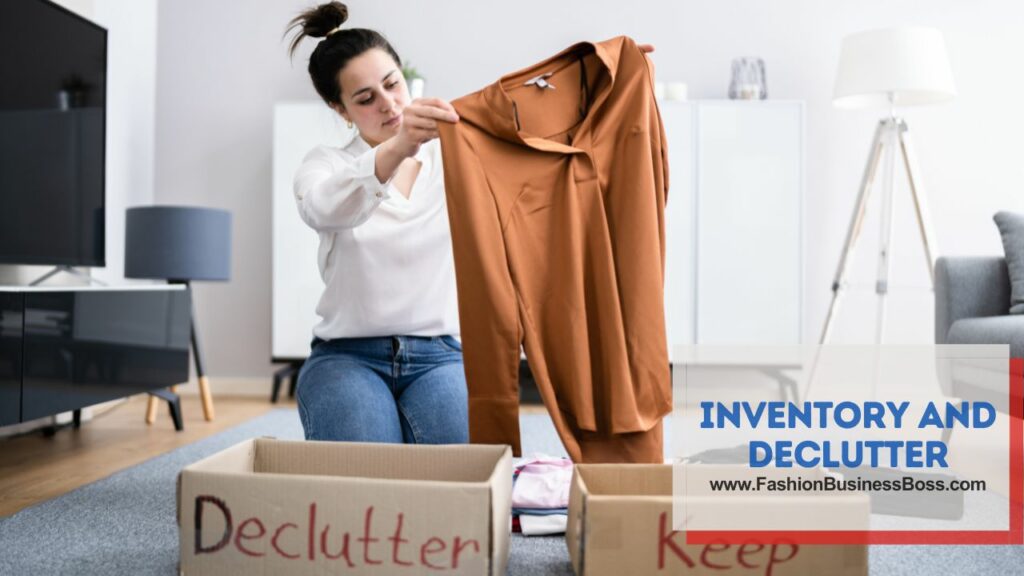Selling your clothes can be an exciting endeavor. Whether you’re looking to declutter your closet, make some extra cash, or start a small business, there are plenty of opportunities in the world of secondhand fashion.
To sell your clothes, start by decluttering and organizing your items. Take quality photos, write clear descriptions, and set reasonable prices. Use online platforms like eBay, Poshmark, or local marketplaces to list your items, and promote them through social media to attract buyers.
In this article, I will walk you through the process step by step, from preparing your clothes for sale to choosing the right platforms and optimizing your listings. Let’s get started!
Inventory and Declutter

Before you dive into the process of selling your clothes, start by doing a little inventory check. This means going through your closet, drawers, and any storage boxes to see what’s in there. Look for things that you haven’t worn or used in a long time, like a year or more. If you spot items like that, it’s a clear sign that you might want to think about selling them.
Now, here’s the key part: be honest with yourself. If you’ve got a dress or a pair of shoes that’s been gathering dust for ages, it’s time to consider giving them a new home. As you go through your stuff, create separate piles or categories.
One pile is for the things you want to sell – these are the items that still have value and can make you some money. Another pile is for stuff you’d like to donate, which can help someone in need. And finally, there’s the discard pile for items that are just too worn or damaged to be useful to anyone.
This process of taking stock and making these separate piles will help you get organized and set the stage for selling your clothes. It’s a practical first step that clears the way for decluttering and potentially earning some cash from your unused items.
Read more about: Starting My Own Clothing Brand: Fashioning Dreams into Wardrobes
Clean and Prepare Your Clothes
When you’re selling clothes, how you present them is super important. People are more likely to buy stuff that looks clean and well-kept. So, before you take those pics for your listings, make sure your clothes are in tip-top shape.
First things first, give your clothes a good wash, especially if they’ve been sitting around for a while. For some pieces that need extra TLC, like fancy dresses or suits, you might want to consider dry cleaning. And if you find any rips or loose buttons, take a few minutes to fix them up – it’ll be worth it.
Nobody likes wrinkled clothes, right? Grab your iron or a steamer and get rid of those wrinkles. Smooth, crease-free clothes just look better in photos.
Speaking of photos, that’s your chance to show off your clothes in the best light – literally! Take your pics in good lighting, preferably natural daylight. Make sure each item is visible and looks its best. High-quality photos can make a big difference in attracting buyers.
Pricing Your Clothes
Setting the right price for your clothes is a big deal. You want to make sure you get a fair deal and that buyers find it attractive. So, here’s how you do it.
First off, do some detective work. Check out similar items that are already up for sale on the platform you’re using. This will give you a sense of what people are willing to pay for stuff like yours. Keep an eye on things like the brand, how good of a shape it’s in, and if it’s a bit unique or rare.
Now, when it comes to setting your price, it’s a bit like a balancing act. You want it to be competitive – not too high that it scares people away, but not too low that you’re giving your stuff away. Think about the item’s true value. Is it a designer brand in excellent condition?
You might be able to ask for a bit more. If it’s a more everyday item, be reasonable. Remember, honesty is the best policy, and setting a fair price will help you attract buyers who are genuinely interested in what you’re selling.
Choose the Right Platform

Selecting the right platform to sell your clothes is essential. There are various options, each with its advantages:
- Online Marketplaces: Websites like eBay, Poshmark, and Depop allow you to create listings for your clothes, reaching a broad audience.
- Local Marketplaces: Craigslist and Facebook Marketplace are great for selling to local buyers who can pick up items in person.
- Consignment Stores: Some stores accept gently used clothing and pay you a percentage of the sale price when your items sell.
- Garage Sales and Flea Markets: These can be excellent options for selling clothes in bulk.
Choose the platform that aligns with your goals and the type of clothing you have to sell.
Read more about: Starting Strong: Equipment for a New Clothing Store
Create Detailed Listings
When creating listings for your clothes, be descriptive and honest. Include the following information:
- Brand and size
- Condition (e.g., new with tags, gently used)
- Measurements (especially for unique or vintage items)
- Material composition
- Any flaws or imperfections
Write a compelling title and description that highlight the item’s features and style. Use natural language, and be sure to answer common buyer questions proactively.
Quality Photography
Good photographs are essential for attracting buyers. Follow these photography tips:
- Use natural light for the best results.
- Take multiple shots from different angles.
- Show close-ups of any unique details.
- Use a plain background that doesn’t distract from the item.
Remember that potential buyers can’t physically touch or try on your clothes, so your photos should provide as much detail as possible.
Promote Your Listings
Getting your items noticed by potential buyers is about more than just depending on the platform’s search engine. You’ve got to put a little effort into spreading the word.
One nifty way to do this is by using social media. If you’ve got a bunch of friends or followers, that’s like your own little fan club! Share your listings there – maybe some of your pals are interested or know someone who is.
Think about it like this: if you’ve got a vintage jacket, and you know there’s a vintage fashion group on Facebook or Instagram, join it! That’s where people who dig what you’re selling hang out. Drop your listing there, and you might just find the perfect buyer.
And don’t forget about hashtags. These little guys can help your listings show up in searches on social media platforms. So, if you’re selling a cool retro t-shirt, toss in some hashtags like #vintagefashion, #retroclothing, or whatever suits your item. It’s like putting a virtual spotlight on your stuff.
The bottom line is, that sharing your listings beyond the selling platform can give your sales a nice boost. It’s all about getting the word out and reaching potential buyers who might not have stumbled upon your items otherwise. So, be social, be savvy, and watch those sales roll in!
Communicate with Buyers

When someone’s interested in what you’re selling, it’s like they’ve knocked on your virtual door. So, it’s a good idea to open that door with a friendly and quick response.
Being prompt is key. When someone shoots you a message asking about your item, don’t leave them hanging. Respond as soon as you can. It shows you’re serious and respectful of their time.
Now, when you reply, be polite and helpful. Answer their questions and give them any extra info they might need. If they want to see more photos, snap those pics and share them. The idea is to make the buying process as smooth as possible for them.
You know, good communication isn’t just about being nice; it’s also about building trust. When potential buyers see that you’re responsive and accommodating, they’re more likely to feel comfortable doing business with you.
Read more about: Starting Strong: How to Create Your Clothing Line Business Plan?
Negotiation and Finalizing the Sale
When it comes to haggling over prices, it’s important to keep an open mind. Some buyers might make offers that are a bit lower than your asking price. Don’t let that throw you off! Instead, think about your bottom line – the lowest price you’re willing to accept. If the offer is close, you can counter with a reasonable price that works for both you and the buyer.
Once you and the buyer agree on a price, it’s time to sort out the nitty-gritty details. Confirm the payment method you both prefer, whether it’s through the platform you’re using or another secure method like PayPal. Also, make sure you’re on the same page about shipping. Figure out who’s covering the shipping costs and how the item will be sent.
One last thing – packaging matters. You’ve put in the effort to sell your item, so package it securely to prevent any damage during the journey. Bubble wrap, sturdy boxes, and some tape can go a long way in ensuring your item reaches its new home in one piece. So, keep those basics in mind, and you’ll be a pro at sealing the deal!
Shipping and Delivery
Selecting the right shipping method is a crucial step in the selling process. It’s essential to choose an option that works well for both you and the buyer. Luckily, many online platforms make it easier by offering shipping labels that you can use.
When it comes to shipping, honesty is the best policy. Be clear about the shipping costs and let the buyer know what to expect in terms of delivery times. Transparency builds trust, and satisfied customers are more likely to leave positive reviews.
After you’ve sent the item on its way, share the tracking information with the buyer. This lets them keep tabs on their purchase and reduces any anxiety about when it will arrive. It’s a small gesture that goes a long way in providing a positive buying experience.
Maintain a Positive Reputation

Building a solid reputation as a seller is like laying a strong foundation for your long-term growth. Here’s how you do it:
First off, ship your items on time. No one likes waiting around for stuff, right? So, when you promise a delivery date, make sure you stick to it.
Secondly, when you describe your items, be as accurate as a GPS. Mention all the details, good and bad, so that buyers know exactly what they’re getting. Honesty is the name of the game.
Now, here’s the kicker – if something goes south with a buyer, deal with it professionally and quickly. Don’t let things fester. It’s better to address issues head-on and find a solution that leaves both you and the buyer satisfied.
And guess what? All this hard work pays off in the form of positive reviews and ratings. Those gold stars and thumbs-up can do wonders for your credibility as a seller. They help attract more buyers and keep the good vibes flowing.
Read more about: Starting Your Clothing Business: A Roadmap to Triumph
Tax Considerations
It’s easy to get excited about the cash you’re making from selling your clothes, but here’s a little reminder: Uncle Sam (or your local tax authority) might want a piece of the pie too. Whether you owe taxes on your sales depends on where you live and how much you make.
Different places have different rules about this stuff. In some areas, if you’re just selling a few items here and there, you might not need to worry too much. But if you’re turning this into a regular gig or making a substantial amount, the taxman might come knocking.
That’s where keeping good records comes in handy. Track your sales, including the dates, amounts, and any expenses related to selling your clothes. You’ll want to have all this info ready if tax time rolls around.
And here’s a smart move: consider talking to a tax pro. They can help you navigate the tax maze and make sure you’re following all the rules. It’s better to be safe than sorry, and getting some expert advice can save you from any tax-related headaches down the road.
Summary
Selling your clothes can be a fulfilling endeavor. By following these steps and maintaining a positive, customer-centric approach, you can declutter your wardrobe, make extra money, and potentially turn your passion for fashion into a sustainable side hustle or business.
So, clean out your closet, snap some great photos, and start selling your clothes today!
Frequently Asked Questions

1. How do I determine the right price for my clothing items?
To set the right price, research similar items online, considering brand, condition, and demand. Be competitive but fair, factoring in wear and rarity.
2. Which platform is best for selling my clothes online?
Choose the platform that aligns with your goals. eBay, Poshmark, and Depop offer broad reach, while local marketplaces like Facebook Marketplace are great for in-person sales. Consignment stores offer another option.
3. What should I do if a buyer is dissatisfied with their purchase?
First, listen to their concerns and try to find a solution. You can offer a refund or accept a return if the issue is legitimate. Good communication and problem-solving can help maintain a positive reputation.
To learn more about starting your own clothing business, check out my startup documents here.
The information provided by FashionBusinessBoss.com (“The Site”) is for general informational purposes only. All information on the Site is provided in good faith, however, we make no representation or warranty of any kind, express or implied, regarding the accuracy, adequacy, validity, reliability, availability or completeness of any information on the Site. Under no circumstance shall we have any liability to you for any loss or damage of any kind incurred as a result of the use of the Site or Reliance on any information provided on the Site. Your use of the Site and your reliance on any information on the Site is solely at your own risk. This blog post is for educational purposes only and does not constitute legal advice. Please consult a legal expert to address your specific needs. Terms and Conditions. (https://fashionbusinessboss.com/terms-and-conditions/)

Meet Shawn Chun: Entrepreneur and Fashion Business Fan.
I’m a happy individual who happens to be an entrepreneur. I have owned several types of businesses in my life from a coffee shop to an import and export business to an online review business plus a few more and now I create online resources for those interested in starting new ventures. It’s demanding work but I love it. I do it for those passionate about their business and their goals. That’s why when I meet a designer or boutique owner at a craft fair, farmers market, retail location or anywhere else I see myself. I know how hard the struggle is to retain clients, find good employees and keep the business growing all while trying to stay competitive.
That’s why I created Fashion Business Boss: I want to help fashion business owners like you build a thriving business that brings you endless joy and supports your ideal lifestyle.

